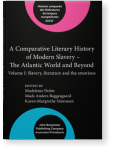Chapter 7
Melodramatic tableaux vivants
Slavery and passionate melancholy in Gertrudis Gómez de Avellaneda’s Sab
The novel Sab (1841) by the Cuban-Spanish writer Gertrudis Gómez de Avellaneda has
been called both a radical anti-slavery novel (Sommer 1991, Davies 2013) and an anti-abolitionist novel that only pays lip service to the
abolitionist cause (Williams 2008, Gomariz, 2009). In this article I approach this ambiguity by moving the focus from content to form and
from story to reader. Building on insights by Peter Brooks (1976), Jacky Bowring (2017) and David Denby
(1994), I argue that formally the novel is a melodramatic tragedy and that its melodramatic tableaux
vivants foster moral reflection in the reader by creating a clash between the ideal and the real and between surface
and depth. I develop this in critical dialogue with ideas about the (dis)connection between emotionality, empathy and
human rights developed by Lynn Hunt (Hunt 2007) and Lynn Festa (2006).
Article outline
- A tragic love story
- Melodrama and the moral universe
- Tableaux vivants in eighteenth-century literature and in Sab: Contradiction and absorption
- The morality of sentiments: Romantic love and the religious vision of natural rights
- Race and moral sentiment
- Melancholic tableaux, melodrama and injustice
-
Notes
-
References
This content is being prepared for publication; it may be subject to changes.
